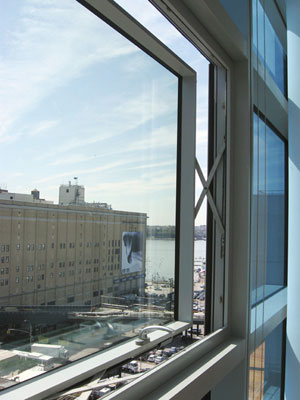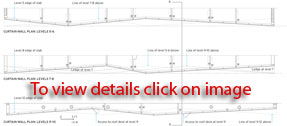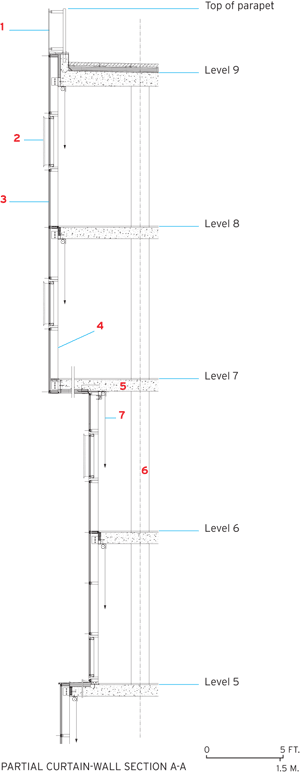Transparency: Literal and Sustainable
Glass in the desert
Creating a high-performing, but transparent, building requires coordination among a broad range of conventional design fields, including facade design, mechanical engineering, lighting design, thermal analysis, and architecture. The parameters that determine occupant comfort and performance-solar heat gain coefficients, daylight factor, visible light transmittance, U-values, and reflectivity-are highly interdependent and never considered in a linear fashion. An integrated design process is more or less mandatory.
For the Cleveland Clinic, slated to open in 2012, the project team settled on the double skin because it satisfied the client's desire for transparency, clarity of design, and optimization of daylight. At the same time, the strategy responded to concerns about glare control and maintenance (exterior sunshades or louvers in Abu Dhabi can present problems, particularly during frequent dust storms). Ted Jacob, whose Oakland, California−based Ted Jacob Engineering Group led the project's mechanical design, says a conventional approach to a double skin relying on operable windows and a natural stack effect wouldn't work in Abu Dhabi's extreme climate.
Since a hospital's clinical areas require full outside air, even the slightest reduction in the ventilation air's temperature prior to passing it over the air-handling unit's cooling coils can amount to significant energy savings. The design temperature Jacob used for Abu Dhabi was 115 degrees, with a patient-room supply-air temperature of 55 degrees, and exhaust air at around 75 degrees after picking up solar, occupant, and equipment loads. Jacob's design exploits the 40-degree difference between the outside and exhaust air by passing recovered exhaust air in pipes through the intakes for the hotter, more humid outside air. The exhaust air warms to about 96 degrees and is then released into the curtain-wall cavity, where it picks up more heat and is vented through louvers at the roof. In conventional practice, that exhaust air would be dumped, but Jacob wrings one more use out of it to provide an invisible layer of insulation between the outer and inner curtain-wall skins.
Solar heat gain and U-values
The solar load on a facade has two primary modes of transfer to the building's interior: radiation and conduction. Radiation is the heat passing through the building envelope in the form of ultraviolet, visible, and infrared light, while conduction occurs from hot to cold surfaces and through air. The solar heat gain coefficient (SHGC), expressed as a percentage, measures the transmission of heat directly through the glass. Glass with a SHGC of 0.30 blocks 70 percent of the solar heat load. The shading coefficient (SC) is more or less the same idea, only it expresses performance against a benchmark of a single 1â„8-inch sheet of clear glass set as 1.0. A SHGC of 0.30 would roughly equate to a SC of 0.35. The SHGC directly affects a glass's U-value, a measure of conductive heat transfer over a given area under standard conditions. A low U-value means very little heat is conducted, either gained or lost, through the glazing. Glass manufacturers provide what they call "center of pane" U-values that address the free-hanging sheet of glass; these are combined into the envelope construction to establish an assembly's overall U-value. The inverse to this is the R-value, a measure of the building element's thermal resistance, or its effectiveness as an insulator.
After first reducing internal loads, designers set about minimizing radiated and conducted loads on the facade. The American Society of Heating Refrigerating and Air-Conditioning Engineers (ASHRAE) publishes data on expected solar gain loads for nearly every climate on the planet. These data set the baseline for sizing a mechanical system, but cooling alone won't shield a building from the effects of the harsh Abu Dhabi sunlight. Reducing glazed surfaces, increasing external reflectivity, providing shading devices, and introducing a low-emissivity (low-E) coating can all limit radiation. For the clinic, the architects introduced an opaque spandrel element on the inner glass skin, in addition to coatings, to reduce radiated heat gain. "The air cavity in the double skin removes some of the conductive heat from the outer skin through a convective means," says Warren Cheng, a project engineer with Ted Jacob. "And because the inner skin is a double pane with an air gap, it's even less sensitive to conductive gain."
Visually, the clinic's facade has two layers, but in reality it is composed of nine. From the exterior working in there are two layers of low-iron glass laminated with a reflective film and applied with an antireflective coating; a nearly 5-foot air gap; a layer of clear glass with a low-E coating; a half-inch argon-filled gap with a suspended coated film; and a final layer of low-iron glass. The outer glass has an SHGC of 0.51 and a visible light transmittance (VLT) of 74 percent, while the inner glass has an SHGC of 0.186 and a VLT of 42 percent.
L+U modeled the glass construction in EnergyPlus to measure the thermal performance. "About half of the solar heat gain is short-wave infrared, which is basically waste heat," says Loisos. "With the coatings, we filter all of the short-wave infrared and nearly all of the ultraviolet." The first layer of reflective film reflects ultraviolet and infrared radiation at the outer skin, thus a smaller amount of heat is absorbed and reradiated by the glass into the cavity, while the spectrally selective suspended film in the inner skin reflects a significant amount of what remains. Both films are clear and don't compromise the envelope's transparency. Coupled with the novel heat-recovery system, the facade design helped the building improve on ASHRAE 90.1-2004 standard by 14 percent.
Of course, not all project budgets have room for a double skin. An increasingly common approach to all-glass facades is to use multiple types of glass with varying performance characteristics. Such a strategy was employed by New York City−based Audrey Matlock, AIA, for the design of the Chelsea Modern, a 47-unit residential building on a tight midblock Manhattan site. She developed the primary facade as a series of stacked bands, accentuated with layers of clear and blue glass, that evoke a sense of lateral movement across the elevation. Jeffrey Ng, AIA, an architect and facade consultant in the New York office of Thornton Tomasetti, says although site constraints permitted only one all-glass facade, the project's thermal design benefited greatly from the balance of glass types. The clear glass has an SHGC of 0.38 and covers 30 percent of the main facade, while the blue-tinted glass has an SHGC of 0.28 and covers the rest. It follows that the actual performance of the total facade lies somewhere between the two.
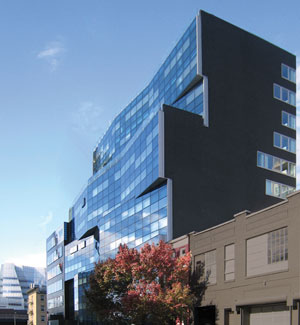
Images: courtesy Audrey Matlock (photos, top, and drawings); Thornton Tomasetti (photo, bottom) |
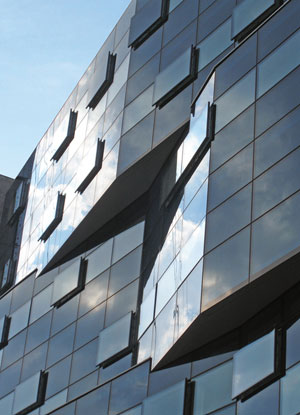
|





